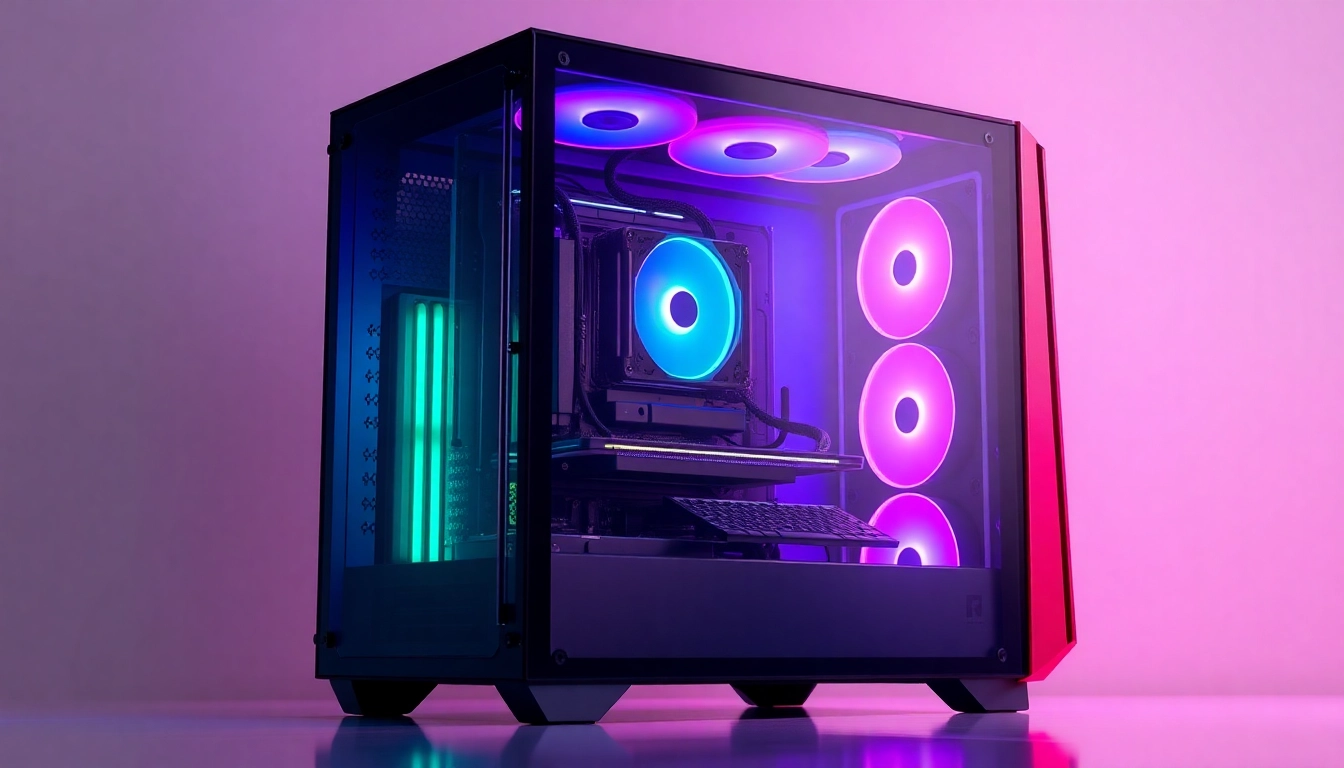Understanding the Importance of a Quality Keyboard
When it comes to enhancing productivity, comfort, and overall user experience, the choice of a quality Keyboard cannot be overstated. While many users may overlook this aspect, the keyboard plays a crucial role in how effectively and efficiently we can interact with our computers and devices. This article explores the significance of investing in a good keyboard and examines its impact on ergonomics, productivity, and user satisfaction.
Why a Keyboard Matters for Productivity
A quality keyboard can have a profound effect on your productivity. Research indicates that users who employ ergonomically designed keyboards tend to experience less fatigue, leading to longer and more productive working sessions. A keyboard that fits comfortably within your hand span and responds quickly to every keystroke minimizes the delay between thought and execution, thereby facilitating a smoother workflow.
Moreover, different types of keyboards cater to specific tasks. For example, mechanical keyboards are favored by gamers for their tactical feedback, which provides a satisfying feel that aids in faster response times. Similarly, touch-typists appreciate the structured layout of standard keyboards that enable efficient typing without looking at the keys. Understanding the relationship between keyboard types and productivity can help you make a strategic decision when selecting a keyboard.
Impact on Ergonomics and Comfort
Ergonomics plays a fundamental role in how users interact with their keyboards over prolonged periods. Poor ergonomic design can lead to repetitive strain injuries (RSIs) such as carpal tunnel syndrome or tendinitis. Key factors to consider include keyboard height, key resistance, and layout. A keyboard that promotes a natural hand position reduces strain on the wrists and fingers.
Adjustable keyboards and those with cushioned palm rests can make significant improvements in comfort. Additionally, some keyboards even feature split designs that allow users to position the two halves of the keyboard according to their shoulder width, creating a more natural alignment of the arms and reducing tension.
Exploring Different Keyboard Uses
Keyboards serve various functions beyond simple text input, each with unique requirements. For instance, musical keyboards aim to replicate the experience of playing a piano, while gaming keyboards provide customizable keys and backlighting for enhanced gameplay. Depending on your primary use case, different features may matter more than the keyboard’s basic function, underlining the importance of understanding how you will use the keyboard before making a purchase.
Types of Keyboards Available
Understanding the various types of keyboards available in the market is essential for making an informed choice. Each keyboard type has its own unique advantages and disadvantages tailored to specific user preferences and requirements.
Mechanical Keyboards: Pros and Cons
Mechanical keyboards are often regarded as the best choice for typing enthusiasts, gamers, and even professional users due to their tactile feedback and durability. These keyboards utilize individual mechanical switches for each key, allowing for precise actuation and ensuring a longer lifespan compared to traditional membrane keyboards.
However, one downside to mechanical keyboards is that they are typically more expensive. Additionally, not everyone appreciates the audible click and the tactile feedback that comes with certain switch types. As a result, it’s important for users to try different mechanical switches to find one that suits their typing style.
Membrane Keyboards vs. Mechanical Keyboards
While mechanical keyboards often get the limelight, membrane keyboards have their own merits. They are lightweight, quieter, and less expensive, making them an attractive option for budget-conscious consumers. Membrane keyboards typically consist of a pressure pad system that requires a little more force to press keys compared to mechanical keyboards.
However, the trade-off is in the typing experience; membrane keyboards lack the tactile feedback that many users appreciate, which can lead to typing fatigue during extended sessions. Understanding the differences can help users choose the right keyboard based on personal preferences and typing habits.
Wireless Keyboards: Convenience and Features
Wireless keyboards are another popular option, favored for their flexibility and lack of cable clutter. They can connect using Bluetooth or a USB dongle, allowing for convenient usage over a distance. Many wireless keyboards come with additional features such as backlighting, multimedia keys, and programmable functions to enhance user convenience.
However, users should bear in mind that battery life can be a concern, particularly for models that do not alert users when the charge is low. Ensuring that your wireless keyboard has adequate battery life and exploring options that utilize rechargeable batteries can mitigate this issue.
Essential Features to Look for in a Keyboard
When selecting a keyboard, it’s essential to consider features that can significantly enhance your typing experience. Here are some critical specifications and functionalities to look for:
Key Switch Types and Their Feel
The feel of a keyboard largely depends on its key switch type, which can significantly impact typing speed and comfort. Common switch types include linear, tactile, and clicky switches, each providing a distinct typing experience. Linear switches, for instance, offer a smooth keystroke with minimal resistance, making them ideal for fast typists, while tactile switches provide a noticeable bump during actuation, which can improve typing accuracy. Clicky switches, on the other hand, are ideal for users who appreciate auditory feedback.
Backlighting Options for Visibility
Backlighting is not only a cosmetic feature but also a practical one. It enhances visibility in low-light conditions, making it easier to see keys during nighttime use. Many keyboards offer customizable RGB lighting that can be adjusted for various preferences or even synced with specific software for gaming enhancements. Understanding the lighting features can aid users in choosing a keyboard aligned with their aesthetic and functional needs.
Programmable Keys and Customization
Customizability increasingly plays a vital role in keyboard selection. Several keyboards come with programmable keys that allow users to assign specific functions or macros to designated keys. This feature is particularly useful for gamers who require quick access to numerous commands or for professionals who benefit from automating repetitive tasks. When choosing a keyboard, consider whether the software supporting key remapping is user-friendly and if it allows for easy adjustments.
Keyboard Maintenance and Care
Maintenance and care are often overlooked yet essential aspects of extending the lifespan of any keyboard. Effective maintenance can ensure that your keyboard remains functional and visually appealing over time.
Cleaning Techniques for Longevity
Regular cleaning is necessary for maintaining hygiene and performance. Dust, crumbs, and oils from fingers can accumulate between keys, affecting typing quality. Simple techniques include using compressed air to dislodge debris and wiping down surfaces with a damp microfiber cloth. For a deeper clean, users can remove keycaps (if applicable) for thorough cleaning. It’s crucial to ensure that the keyboard is unplugged before attempting any cleaning to prevent accidental short circuits.
How to Avoid Common Issues
Some common issues with keyboards include unresponsive keys or input lag. To avoid such problems, it’s advisable to keep the keyboard free from moisture and food particles and to use it on appropriate surfaces. Ensuring that you have the correct drivers installed and regularly updating them can help mitigate software-related issues. Using a keyboard cover can also protect against spills and dust accumulation.
Upgrading Components for Enhanced Performance
For mechanical keyboard enthusiasts, upgrading individual components such as switches, keycaps, or stabilizers can lead to significant enhancements in typing feel and performance. This customization allows users to create a keyboard tailored to their specific requirements and preferences. Many online resources provide guides on how to achieve various customization options successfully.
Choosing the Right Keyboard for Your Needs
With the multitude of keyboard options available, selecting the right one can be overwhelming. The ideal keyboard should align with your tasks, preferences, and workspace setup. Here are some factors to consider:
Identifying Your Usage Context: Gaming vs. Typing
Determine what you primarily need the keyboard for. Gamers often prioritize responsiveness and tactile feedback, while typists may prioritize comfort for extended writing sessions. If you fall into both categories, consider a hybrid keyboard that caters to various needs. Central to this choice is the understanding that certain designs and features work better for specific tasks.
Budget Considerations for Different Models
Keyboards come in a wide range of prices. While it’s tempting to choose the cheapest option, investing a little more can yield significant benefits in terms of durability and performance. Consider what additional features justify a higher price point, such as customizable entries or mechanical switch types.
Understanding Personal Preferences and Ergonomic Needs
Every user has different preferences. Before purchasing, it’s critical to consider your ergonomic needs and typing style. Users who tend to type heavily might benefit from an ergonomic or mechanical option, while casual users may find membrane keyboards sufficient. Furthermore, the aesthetics of the keyboard may play an essential role in your choice. Researching user reviews can provide insight into how satisfied others are with their selections, helping to guide your decision.



